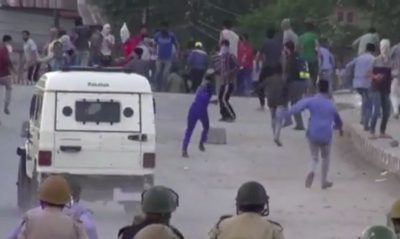Is India Preparing to Unleash “Weapons of Mass Migration” in Kashmir?

The planned deployment of 20,000 more paramilitary forces in occupied Kashmir has raised serious concern among the locals that India is preparing to rescind Article 35A ahead of the country’s upcoming independence day celebrations next month, which would allow non-residents to purchase property in the region and possibly lead to the disruptive large-scale influx of foreigners along the lines of Ivy League scholar Kelly M. Greenhill’s “Weapons of Mass Migration” model.
A Military Deployment For Political Ends
The indigenous population of Indian-occupied Kashmir is becoming seriously concerned that New Delhi is preparing to rescind Article 35A ahead of the country’s upcoming independence day celebrations next month following the planned deployment of 20,000 more paramilitary forces to the region. The aforementioned provision bars non-residents from purchasing property there, which was thought at the time to be a clever tactic for quelling pro-independence unrest following India’s occupation of the formerly independent country. Popular international political commentator and former Indian diplomat Melkulangara Bhadrakumar, however, revealed in a recent op-ed curiously published just a few days before the phased deployment began that “the Modi government plans to integrate J&K by divesting or eroding some of its so-called ‘special status’”, hinting that there might be some credence to the locals’ concerns given that such a well-connected individual as Mr. Bhadrakumar himself thought it fitting to publicly make his “reasonable guess” at such a coincidental time.
No Comparison To China
The Khalistan Factor
A Dangerous Mistake
As the Modi government has been prone to do over the past half-decade, this speculated policy would represent yet another massive mistake if it’s ever implemented. Not only has the planned military deployment already generated intense talk about occupied Kashmir’s “autonomy” — thus negating the possible purpose of keeping such discourse out of the national discussion following the revival of the Khalistan movement — but it could also lead to more forceful resistance from the locals who fear an impending demographic invasion of ‘Weapons of Mass Migration”. Modi clearly wants to deliver on his party’s recent election promise to eliminate Articles 370 and 35A granting “autonomy” to Kashmir and the right to residents to be the sole purchasers of property in the occupied region respectively, but the blind devotion to electioneering rhetoric could prove to be extremely dangerous in this context because of the high likelihood that it’ll backfire by drawing intense international condemnation and possibly even provoking uncontrollable violence.
*
Note to readers: please click the share buttons above or below. Forward this article to your email lists. Crosspost on your blog site, internet forums. etc.
This article was originally published on Eurasia Future.
Andrew Korybko is an American Moscow-based political analyst specializing in the relationship between the US strategy in Afro-Eurasia, China’s One Belt One Road global vision of New Silk Road connectivity, and Hybrid Warfare. He is a frequent contributor to Global Research.

